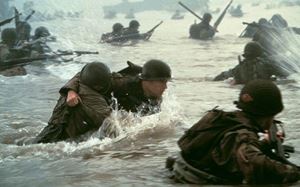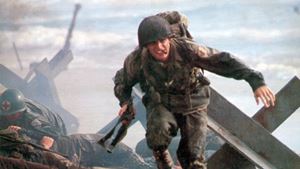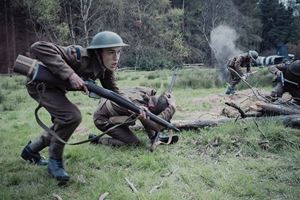
Among the episodes of the Second World War, the Normandy landing, also called D-Day, is one of the most legendary and represented in cinema. That battle fought on 6 June 1944 on the beaches called Omaha and Utah by 156,000 men from four nations (USA, England, France and Canada), and which was the beginning of the Nazi defeat in Europe, cost the allies the loss of 7,844 among the dead, wounded and missing on the beaches, to which were added 3,799 dead, wounded and missing among the airborne troops. From the very moment it was fought, the battle was documented by many great directors of American cinema who followed the troops: John Ford, George Stevens and Billy Wilder. The first spectacular film that tells the story of the landing, and it goes broadcast tonight 25 October on Rai Movie, it was The longest day (1962) based on the 1959 historical essay of the same name by Cornelius Ryan. Directed by five directors, it features a stellar cast: John Wayne, Henry Fonda, Robert Mitchum, Richard Burton, Sean Connery.

A scene from “Saving Private Ryan”
The name Spielberg chose for the protagonist of his blockbuster was a clear homage to the historian Cornelius Ryan Save Private Ryan (1988), 11 nominations and 6 Oscars, including the one for directing. The long scene that opens the film and which describes the moment of the landing, in its crudeness and truthfulness, is one of the most spectacular in the history of cinema. The inspiration for the story told instead comes from another war episode. The screenwriter Robert Rodat near Putney Corners, New Hampshire, had seen a monument in memory of the fallen during different conflicts, from the American Civil War to the Vietnam War. Rodat noted the names of eight brothers who perished during the Civil War. When he decided to write the story of a family destroyed by war he chose to set it during World War II and was inspired by the true story of the four Niland Brotherstwo of whom died during the landing (a third believed to have died there but was discovered to be a prisoner in Burma) while the fourth brother, Fritz, was returned to the United States.

It veers towards the spy genre The Last 36 Hours (1964) by George Seaton, based on the short story Beware of the Dog by Roald Dahl, who participated in the Second World War in aviation and who later became one of the most famous children’s writers. This is the plot: Major Jeff Pike (James Garner) participated in General Eisenhower’s last briefing on the Normandy landings in early June. Captured in Portugal, he is made to believe when he wakes up that he is in post-war Germany in 1950, having been tortured and suffering from amnesia. He begins to tell details of the invasion to Nurse Anna (Eva Marie Saint) and Doctor Gerber (Rod Taylor), but when he realizes the trick, he begins a personal challenge to escape and at the same time try not to reveal the details of the D to the Germans -Day.
Very little triumphalistic but very human Operation Overlord directed by Stuart Cooper and winner of the Silver Bear at the Berlin Film Festival. The film tells the story of D-Day following the fate of the young English soldier Tom Beddows (Brian Stirmer). Called up for military service in 1944, after escaping a bombing and returning to a destroyed London, risking being condemned as a deserter, he found himself involved in training for the Normandy landings. While sailing he has premonitory nightmares: in fact, a few meters from the French beach, he is hit in the forehead and is the first victim of the great landing.
Based on his experience as a World War II veteran THEThe Big Red One (1980) by director Sam Fuller No Hollywood rhetoric in reconstructing the main war scenarios, from the African deserts to the Belgian forests, from Sicily to, of course, the beaches of Normandy. With Lee Marvin, Mark Hamill and Robert Carradine

By a curious and mysterious phenomenon in 2023, in view of the 80th anniversary of the Normandy landings, two English films were released, both based on the true story of the Second World War veteran Bernie Jordan, known to the media by the nickname “the great fugitive”, for having escaped at the age of almost ninety from a retirement home to return to the Normandy landing beach. Escape to Normandy stars Michale Caine and Glenda Jackson in what was the actress’s last film appearance before her death. We are in Dover, 2014. Bernie Jordan is almost ninety years old and has a great dream: to attend the 70th anniversary of the Normandy landings, which he participated in as a young recruit in the Navy. Irene, known as Rene, his wife of 70 years, is ill and hospitalized in a nursing home where Bernie has also decided to move so as not to be away from her, even though he is still quite autonomous and independent. When he discovers that he has arrived too late to book the trip organized by the Dover veterans intending to participate in the D-Day celebrations, Bernie decides to leave alone, with the approval of Rene who does not warn the nursing home staff so as not to prevent to her husband to make his dream come true.
Similar story in The Last Rifleman – Return to Normandywhere they changed the name of the character, who here is called Artie Crawford (played by Pierce Brosnam artfully aged), the ceremony is for the 75th anniversary of D-Day, and where the death of his wife, admitted to a nursing home of Northern Ireland, is the trigger that leads to the escape of the elderly man.







